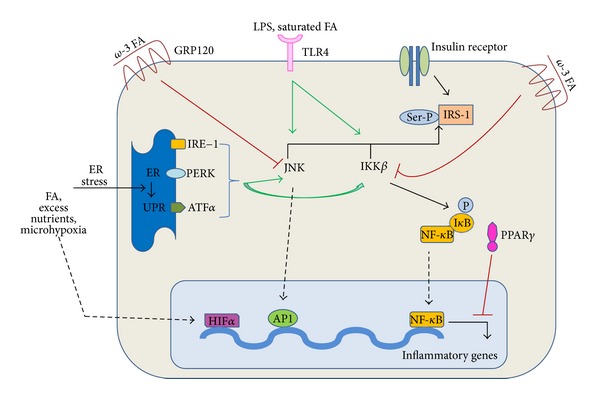Figure 2.

Various signaling pathways promoting or inhibiting inflammatory signaling (green arrows represent activation, and red arrows represent inhibition). Jun N-terminal kinase-1 (JNK1) and inhibitor of kB kinase (IKKβ) are inflammatory signaling pathways which promote insulin resistance. Activation of either pathway leads to serine phosphorylation of insulin receptor substrate protein-1 (IRS-1), causing attenuation of insulin action. IKKβ also phosphorylates inhibitor of nuclear factor-κB (IκB) which essentially frees nuclear factor-κB (NF-κB), allowing it to translocate to the nucleus, bind to DNA, and activate inflammatory mediators. JNK1 can also stimulate transcription of inflammatory genes in association with transcription factor activator protein 1 (AP1). Toll-like receptor 4 (TLR4) activation, which normally binds lipopolysaccharides (LPS) and saturated fatty acids (FA), results in activation of JNK and IKKβ. Endoplasmic reticulum (ER) stress, stimulated by FA, nutrient excess, and microhypoxia, leads to the unfolded protein response (UPR). UPR comprises three main pathways: inositol-requiring enzyme (IRE)-1, protein kinase-like ER kinase (PERK), and activating transcription factor (ATF)α which all lead to activation of JNK1 and IKKβ. Hypoxia also activates the transcription factor hypoxia-inducible factor-1α (HIF-1α), which induces expression of various target genes. Conversely, insulin sensitivity is promoted by activation of the omega-3 fatty acid receptor (GRP120) which inhibits JNK1 and IKKβ. PPARγ also promotes insulin sensitivity by interfering with the NF-κB and AP1 signaling pathways and subsequent expression of inflammatory genes.
